|
A list of the most Impressive and Historic
Buildings around Glasgow centre in order to walk
round.
Each of these Glasgow Buildings are well worth
viewing to take in the excellent Stonework. You can
also view the Interior of some as well.
Look out for some of the Neighbouring Buildings as
well, as many were built to compete with the top
Buildings.
Most Buildings are built with a local Sandstone,
Golden in colour. The Red Sandstone was brought in
from the Southwest of Scotland, so was more
expensive.
|

The Glasgow City Chambers building is on the east
side of George Square, in the centre of Glasgow,
completed in 1888 in the Beaux Arts Style by the
Architect William Young. The City Chambers were
opened by Queen Victoria. You can take tours of the
inside most days. The large red sandstone Royal
College Building, built in 1903, is on the left in
the image above.
Wiki Page . Map G2 1DU
|

The old General Post Office Building is on George
Square's south side, completed in 1878 by the
Architect Robert Mathieson, re-modeled between 2007
and 2012 with a glass roof, retaining only the outer
shell. The Building now contains a number of
businesses including restaurants.
|

Next to the old General Post Office Building on
George Square's south side is Lomond House offices
built in 1922 to designs of James Miller.
|

The Counting House building is on the southwest
corner of George Square, built to be the Bank of
Scotland's headquarters, completed by the Architect J
T Rucheadin in 1870, in the Italian Renaissance
style. The Building now serves as a Bar Diner and
Greek Restaurant.
|

The Merchants House is on the northwest corner of
George Square, next to the Counting House, completed
in 1877 by the Architect John Burnet. The Merchants
House has been run by Glasgow Merchants since the
1600s, helping to develop Glasgow for business and
its community.
|

St George's Tron Church is on Buchanan Street,
about 200 yards west of George Square's northwest
corner at the Counting House, completed in 1808, as
St. George's Parish Church, by the Architect William
Stark. The Building now serves as a Church of
Scotland Parish Church. You can visit when there are
no services.
Wiki Page . Map G1 2JX
|

The Town House is at 167 Buchanan Street, on the
north side of the Tron Church. This building was
completed in 1911, used over the years as a Liberal
Club, for Music and Art. The building now houses a
vast Thai Restaurant over 4 floors. Next door is the
impressive, but narrow, Athenaeum Theatre Building
completed in 1893, it held the Hard Rock Cafe for a
many years.
Map G1 2LL
|
|
 The Glasgow Stock Exchange building is
at 147 Buchanan Street, on the south side of the Tron
Church, completed in 1887 by the Architect John
Burnet, in the Venetian Gothic style. The Building
now holds the Apple Computing Store. The Glasgow Stock Exchange building is
at 147 Buchanan Street, on the south side of the Tron
Church, completed in 1887 by the Architect John
Burnet, in the Venetian Gothic style. The Building
now holds the Apple Computing Store.
Wiki Page. Map G1 2JX
|
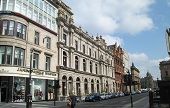
The Clydesdale Bank building is at 32 St Vincent
Place, next to Buchanan Street, just south of the
Glasgow Stock Exchange building, completed in 1874 by
the Architect John Burnet. The Clydesdale Bank has
been one of the major Banks in Scotland since
1838.
Map
|

Across the road from the Clydesdale Bank building
is the Scottish Provident building completed in 1908
by the architect Dick Peddie. This building now has a
the Ralph & Finns
Restaurant that just has to be seen.
|
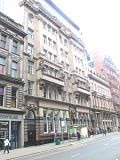
110 St Vincent Street is on St Vincent Street, a
couple of hundred yards west of the Clydesdale Bank
Building, completed in 1927 by the Architect James
Miller, in the American Neoclassical Architecture,
for the Union Bank of Scotland. The Bank of Scotland
now uses the building.
Map
|
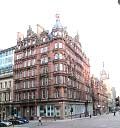
The Liverpool and London and Globe Insurance
building is on the corner of Hope Street and St
Vincent Street, next to the 110 St Vincent Street.
This building was completed in 1898 by the Architects
Baird and Thompson.
|
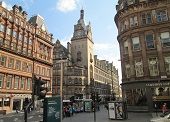
The Grand Central Hotel is at Glasgow Central
Train Station, on Gordon Street and Hope Street,
about 200 yards down from the Liverpool Insurance
building, completed in 1883 by the Architect Robert
Rowand Anderson, in Queen Anne Style. You can visit
for a look round and have a drink or a meal. The
hotel bar/diner named Champagne Central has good
views over the Train Station.
Wiki Page . Map G1 3SF
|
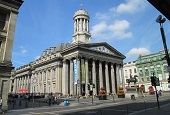
The Gallery of Modern Art is in the Royal Exchange
Square, about 300 yards east of Central Station, 200
yards southwest of George Square, originally
completed as a Town House in 1778 for William
Cunninghame, a wealthy Glasgow Tobacco Lord. The
Corinthian pillars and clock tower were added in
1832. The interior is well worth viewing.
RSS Page . Map G1 3AH
|
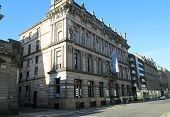
The Corinthian building is on Ingram Street, about
100 yards east along from the Gallery of Modern Art,
completed in 1842 by the Architect David Hamilton, as
the Glasgow Ship Bank. The building now houses the
Corinthian Club with Bars,
Restaurants, and a Casino. You can pop in for a drink
and a look around.
Map G1 1DA
|

The Glasgow Old Sherrif Court is on Ingram Street
and Wilson Street, completed in 1844 in Neo-Classical
Design, by the Glasgow based Architects William
Clarke & George Bell. The building now holds the
Scottish Youth Theatre, shops and diners.
Map G1 1DW
|

Hutchesons Hall is on Ingram Street, next to the
Old Sherrif Court, completed in 1805 by the Architect
David Hamilton. The building was built for two
Glasgow Lawyers, who left funds in trust to build a
School for Poor Boys, Orphans, and also Old Men. The
building is currently used as a Restaurant.
Map G1 1EJ
|

The Ramshorn Kirk is on Ingram Street, a block
east of Hutchesons Hall, completed in 1824 by the
Architect Thomas Rickman. The Graveyard is said to
have been often robbed of Bodies for the University
of Glasgow. The building is owned by the University
of Strathclyde, who used it as the Ramshorn Theatre
for some time.
Information .
Map G1 1EX
|
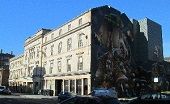
The City Halls building is on Albion Street, a
block east of the Ramshorn Building, completed in
1841 by the Architect George Murray. The Painting on
the north end of the building was added in about 2012
by the Australian artist Sam Bates.
Map G1 1NY
|

The Merchant Square building is on Albion Street,
about 100 yards south of the City Halls, built in the
1800s as a Merchant's Market. The building now houses
a number of Restaurants.
Website . Map G1 1NY
|

The Trongate Royal Bank of Scotland building is at
186 Trongate, on the west end of the Trongate, a few
hundred yards southwest of the Merchant Square. This
Building was completed in 1903, in Mixed Renaissance
Style. The building was converted to apartments in
2015 with a Cafe on the ground floor.
Map G1 5RY
|
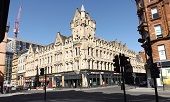
The Trongate Town Hall, or Tontine building, is at
66 Trongate. Much of the building that can be seen
today, was completed in 1781 by the Architect William
Hamilton. Now mainly used as Shops, Bar Diners,
Restaurants, and Holiday Apartments.
Map G1 5EP
|
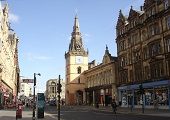
The Tron Kirk Theatre is across from the Trongate
Town Hall at 63 Trongate. The Kirk / Church was built
in the 1600s, converted to the Tron Theatre in the
1980s.
Map G1 5HB
|
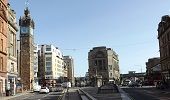
The Mercat Building with the Mercat Cross in
front, are at Glasgow Cross at the end of the
Trongate, with the Tolbooth Steeple to the left of
them in this image. This building was completed in
1928, the Cross in 1929 to replace an earlier Cross
from the 1600s or before. Mercat stands for Market,
as this is where a large Market was situated, where
five Roads meet at Glasgow Cross. The Tolbooth here
was completed in 1636 to replace an older one from
the 1300s.
Map G1 1LX
|
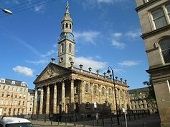
St Andrew's Square is about 200 yards southeast of
Glasgow Cross. The main building in the Square is the
former St Andrew's Church, completed in 1754, now
used for private functions such as Weddings and
Family Party's.
Map G1 5PP
|

The Old High Court is 300 yards southwest of St
Andrew's Square at the entrance to Glasgow Green
Park, in the area known as Saltmarket, built in 1814
by the Architect William Stark in the neoclassical
style.
Map G1 5JT
Glasgow Green park holds the Peoples
Palace Museum, well worth visiting when here.
|
|
